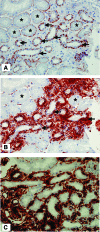Early epithelial phenotypic changes predict graft fibrosis
- PMID: 18434568
- PMCID: PMC2488257
- DOI: 10.1681/ASN.2007101160
Early epithelial phenotypic changes predict graft fibrosis
Abstract
Chronic allograft nephropathy accounts for the loss of approximately 40% of allografts at 10 yr. Currently, no biomarker is available to detect interstitial fibrosis and tubular atrophy in the renal graft at an early stage, when intervention may be beneficial. Because tubular epithelial cells have been shown to exhibit phenotypic changes suggestive of epithelial-to-mesenchymal transition, we studied whether these changes predict the progression of fibrosis in the allograft. Eighty-three kidney transplant recipients who had undergone a protocol graft biopsy at both 3 and 12 mo after transplantation were enrolled. De novo vimentin expression and translocation of beta-catenin into the cytoplasm of tubular cells were detected on the first biopsy by immunohistochemistry. Patients with expression of these markers in >or=10% of tubules at 3 mo had a higher interstitial fibrosis score at 1 yr and a greater progression of this score between 3 and 12 mo. The intensity of these phenotypic changes positively and significantly correlated with the progression of fibrosis, and multivariate analysis showed that their presence was an independent risk factor for this progression. In addition, the presence of early phenotypic changes was associated with poorer graft function 18 mo after transplantation. In conclusion, early phenotypic changes indicative of epithelial-to-mesenchymal transition predict the progression toward interstitial fibrosis in human renal allografts.
Figures




Similar articles
-
Epithelial-to-mesenchymal transition in early transplant tubulointerstitial damage.J Am Soc Nephrol. 2008 Aug;19(8):1571-83. doi: 10.1681/ASN.2007050580. Epub 2008 May 14. J Am Soc Nephrol. 2008. PMID: 18480317 Free PMC article.
-
Outcomes of de novo allograft diabetic nephropathy in renal allograft recipients.Exp Clin Transplant. 2013 Jun;11(3):215-21. doi: 10.6002/ect.2012.0193. Exp Clin Transplant. 2013. PMID: 23767942
-
Utility of Serial Protocol Biopsies Performed After 1 Year in Predicting Long-Term Kidney Allograft Function According to Histologic Phenotype.Exp Clin Transplant. 2018 Aug;16(4):391-400. doi: 10.6002/ect.2016.0323. Epub 2017 Dec 5. Exp Clin Transplant. 2018. PMID: 29206090
-
Diagnosis of interstitial fibrosis and tubular atrophy in kidney allograft: implementation of microRNAs.Iran J Kidney Dis. 2014 Jan;8(1):4-12. Iran J Kidney Dis. 2014. PMID: 24413714 Review.
-
Chronic allograft nephropathy or interstitial fibrosis and tubular atrophy: what is in a name?Curr Opin Nephrol Hypertens. 2014 May;23(3):245-50. doi: 10.1097/01.mnh.0000444811.26884.2d. Curr Opin Nephrol Hypertens. 2014. PMID: 24626060 Review.
Cited by
-
Novel approach for the detection of tubular cell migration into the interstitium during renal fibrosis in rats.Fibrogenesis Tissue Repair. 2015 Jul 10;8:12. doi: 10.1186/s13069-015-0030-0. eCollection 2015. Fibrogenesis Tissue Repair. 2015. PMID: 26161140 Free PMC article.
-
High glucose induces an activated state of partial epithelial-mesenchymal transition in human primary tubular cell cultures.PLoS One. 2023 Feb 24;18(2):e0279655. doi: 10.1371/journal.pone.0279655. eCollection 2023. PLoS One. 2023. PMID: 36827456 Free PMC article.
-
Renal studies provide an insight into cardiac extracellular matrix remodeling during health and disease.J Mol Cell Cardiol. 2010 Mar;48(3):497-503. doi: 10.1016/j.yjmcc.2009.07.022. Epub 2009 Jul 30. J Mol Cell Cardiol. 2010. PMID: 19646990 Free PMC article. Review.
-
Macrophage-Induced Pro-Fibrotic Gene Expression in Tubular Cells after Ischemia/Reperfusion Is Paralleled but Not Directly Mediated by C5a/C5aR1 Signaling.Life (Basel). 2024 Aug 19;14(8):1031. doi: 10.3390/life14081031. Life (Basel). 2024. PMID: 39202772 Free PMC article.
-
How tubular epithelial cells dictate the rate of renal fibrogenesis?World J Nephrol. 2015 Jul 6;4(3):367-73. doi: 10.5527/wjn.v4.i3.367. World J Nephrol. 2015. PMID: 26167460 Free PMC article. Review.
References
-
- Cornell LD, Colvin RB: Chronic allograft nephropathy. Curr Opin Nephrol Hypertens 14: 229–234, 2005 - PubMed
-
- Harris RC, Neilson EG: Toward a unified theory of renal progression. Annu Rev Med 57: 365–380, 2006 - PubMed
-
- Annual report. Agence Biomedecine, Paris, 2006, p 153. Available at: http://www.agence-biomedecine.fr/fr/experts/doc/rapp-synth2006.pdf. Accessed August 20, 2007
-
- Mannon RB: Therapeutic targets in the treatment of allograft fibrosis. Am J Transplant 6: 867–875, 2006 - PubMed
-
- Chapman JR, O'Connell PJ, Nankivell BJ: Chronic renal allograft dysfunction. J Am Soc Nephrol 16: 3015–3026, 2005 - PubMed
Publication types
MeSH terms
LinkOut - more resources
Full Text Sources
Other Literature Sources
Medical

